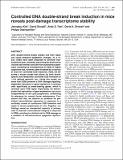| dc.contributor.author | Kim, Jeongkyu | en_US |
| dc.contributor.author | Sturgill, David | en_US |
| dc.contributor.author | Tran, Andy D. | en_US |
| dc.contributor.author | Sinclair, David A. | en_US |
| dc.contributor.author | Oberdoerffer, Philipp | en_US |
| dc.date.accessioned | 2016-05-02T16:59:18Z | |
| dc.date.issued | 2016 | en_US |
| dc.identifier.citation | Kim, Jeongkyu, David Sturgill, Andy D. Tran, David A. Sinclair, and Philipp Oberdoerffer. 2016. “Controlled DNA double-strand break induction in mice reveals post-damage transcriptome stability.” Nucleic Acids Research 44 (7): e64. doi:10.1093/nar/gkv1482. http://dx.doi.org/10.1093/nar/gkv1482. | en |
| dc.identifier.issn | 0305-1048 | en |
| dc.identifier.uri | http://nrs.harvard.edu/urn-3:HUL.InstRepos:26859965 | |
| dc.description.abstract | DNA double-strand breaks (DSBs) and their repair can cause extensive epigenetic changes. As a result, DSBs have been proposed to promote transcriptional and, ultimately, physiological dysfunction via both cell-intrinsic and cell-non-autonomous pathways. Studying the consequences of DSBs in higher organisms has, however, been hindered by a scarcity of tools for controlled DSB induction. Here, we describe a mouse model that allows for both tissue-specific and temporally controlled DSB formation at ∼140 defined genomic loci. Using this model, we show that DSBs promote a DNA damage signaling-dependent decrease in gene expression in primary cells specifically at break-bearing genes, which is reversed upon DSB repair. Importantly, we demonstrate that restoration of gene expression can occur independently of cell cycle progression, underlining its relevance for normal tissue maintenance. Consistent with this, we observe no evidence for persistent transcriptional repression in response to a multi-day course of continuous DSB formation and repair in mouse lymphocytes in vivo. Together, our findings reveal an unexpected capacity of primary cells to maintain transcriptome integrity in response to DSBs, pointing to a limited role for DNA damage as a mediator of cell-autonomous epigenetic dysfunction. | en |
| dc.language.iso | en_US | en |
| dc.publisher | Oxford University Press | en |
| dc.relation.isversionof | doi:10.1093/nar/gkv1482 | en |
| dc.relation.hasversion | http://www.ncbi.nlm.nih.gov/pmc/articles/PMC4838352/pdf/ | en |
| dash.license | LAA | en_US |
| dc.title | Controlled DNA double-strand break induction in mice reveals post-damage transcriptome stability | en |
| dc.type | Journal Article | en_US |
| dc.description.version | Version of Record | en |
| dc.relation.journal | Nucleic Acids Research | en |
| dash.depositing.author | Sinclair, David A. | en_US |
| dc.date.available | 2016-05-02T16:59:18Z | |
| dc.identifier.doi | 10.1093/nar/gkv1482 | * |
| dash.contributor.affiliated | Sinclair, David | |


